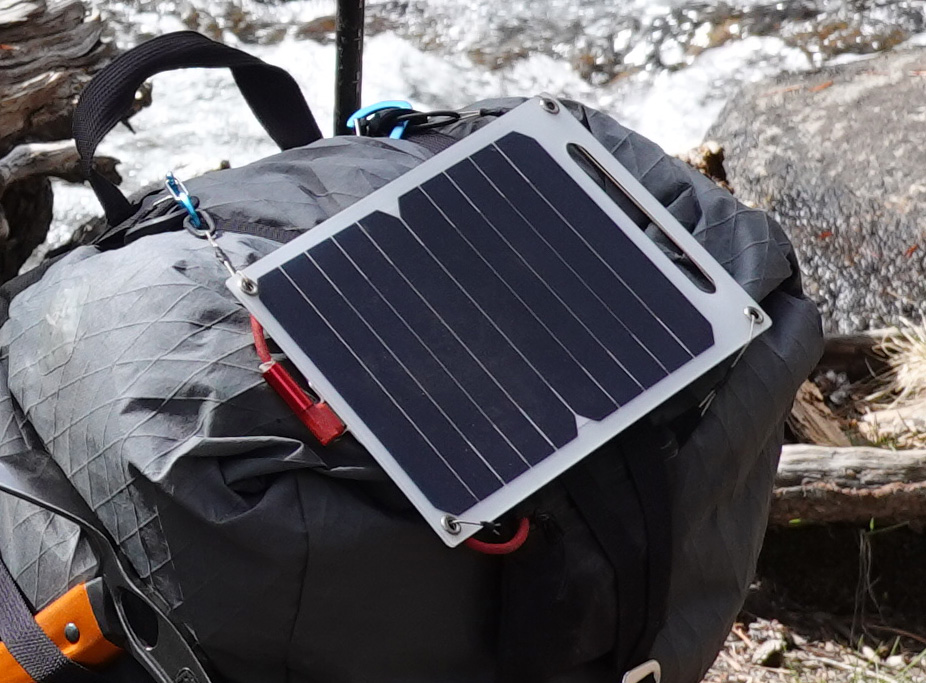This is no political demand – I just write about electricity.
How much of it you may need on trail will depend a lot on the devices you carry, and how you use them. You have to find out yourself by your own tests. Nowadays most devices can be charged from USB. You can buy a cheap USB energy meter, e. g. on eBay, which you can put between a charger and your devices, and thus monitor the energy your devices need after the intended use for a certain period. Note the results and add them up, maybe make a little spreadsheet.

My gear is quite power-hungry because I carry a camera system which I want to use extensively, including maybe thousands of night photos for timelapse videos. I will take more than 300 GB SD cards with me. I expect up to one full charge of a camera battery per day.
In addition I want to use my inReach for tracking points sent via satellite every 10 minutes, and some SMS communication in the evenings, and the smartphone for navigation and trail information.
Possible power sources are:
-
- A USB wall charger
- One or multiple power banks
- Solar panels
Obviously the wall charger can only be used where you have line power: before the start, and at some resupply points. And don’t forget: charging needs time. Use a charger with more than one output so that you can charge multiple devices in parallel – if you have enough cables.
It may be a good strategy to carry one or two power banks to charge your devices on trail, and then recharge the power bank(s) where possible. In 2019 a 10 Ah power bank seems to give the best compromise between weight and time for a recharge; bigger ones often need considerably longer charging. So it can be smart to carry two smaller instead of one bigger, if one is not enough, and you plan to recharge where you do not stay overnight. This also gives you some redundancy on trail. For the same reason carry more than one USB cable. I am lucky that all my devices can be charged via a micro USB connector so that I need only one type of cable.
For my “10.000 mAh” (10 Ah is the internal battery capacity at 3.6 V) Anker power bank I measured at 5 V USB a possible output of 6 Ah (=30 Wh Energy, or 0.03 kWh), while it then needs about 8,5 Ah (40…45 Wh) for a full recharge. There are losses both in the input and output voltage converters and the Li cell itself which add up to only 70% overall efficiency.
Solar panels can help you to recharge on trail. Most panels are too heavy for their power output because they are built sturdily. We want to go light. I ended with a so called “10 W” solar charger which can be bought for less than 15 US$ on sites like aliexpress or banggood. You can expect a solid 3.5 W from this panel on a sunny day with good illumination. And it weights less than 70 g. I modified it a bit with four extra holes of 2 mm diameter for better fixation. The small bag made out of DCF weights 7 g and is just big enough for the Anker 10 Ah power bank. The eyelets are rubber O-rings, the string is a fishing line claimed to be out of dyneema, and I secured its knotted ends with heat-shrinking tube.
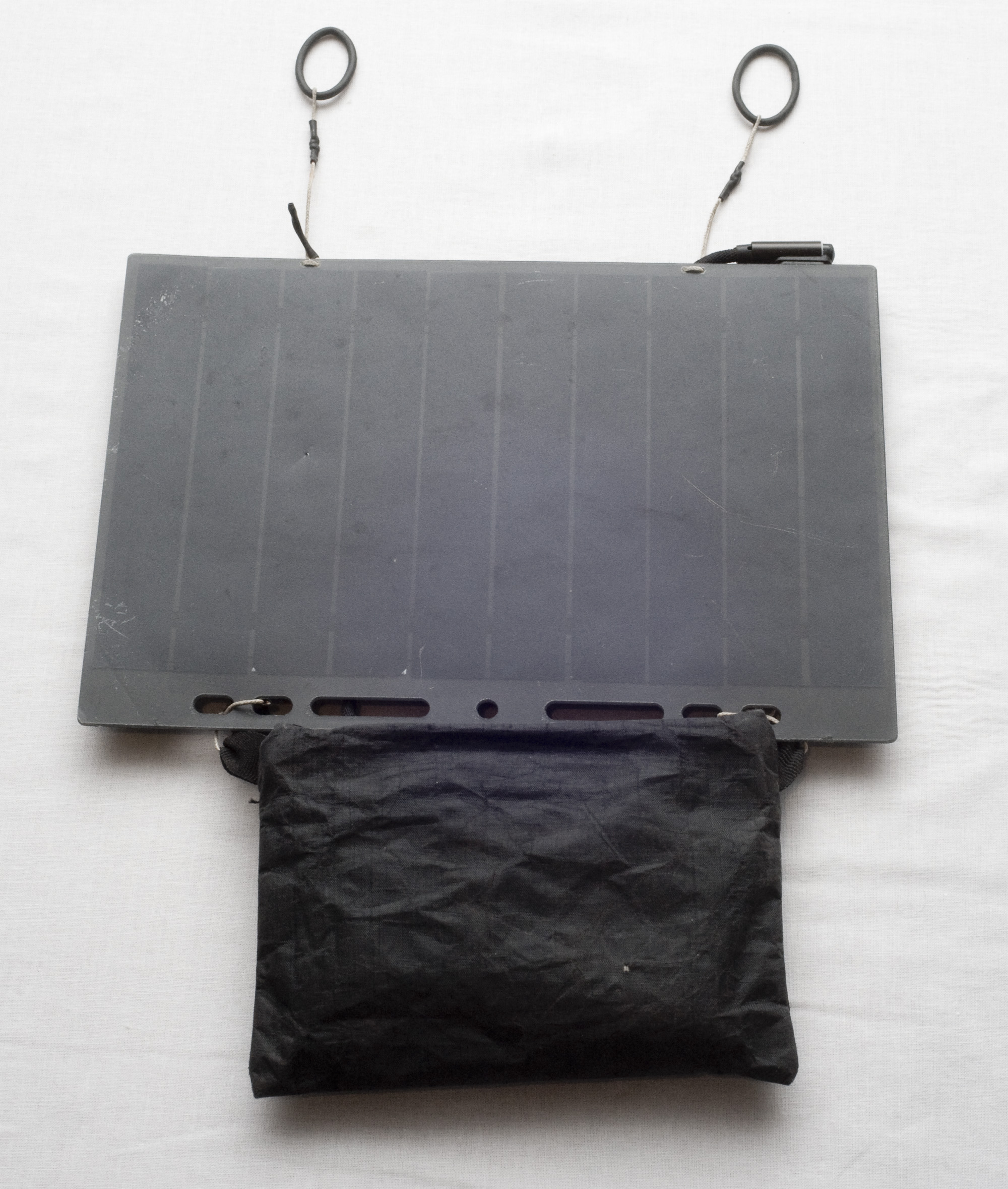
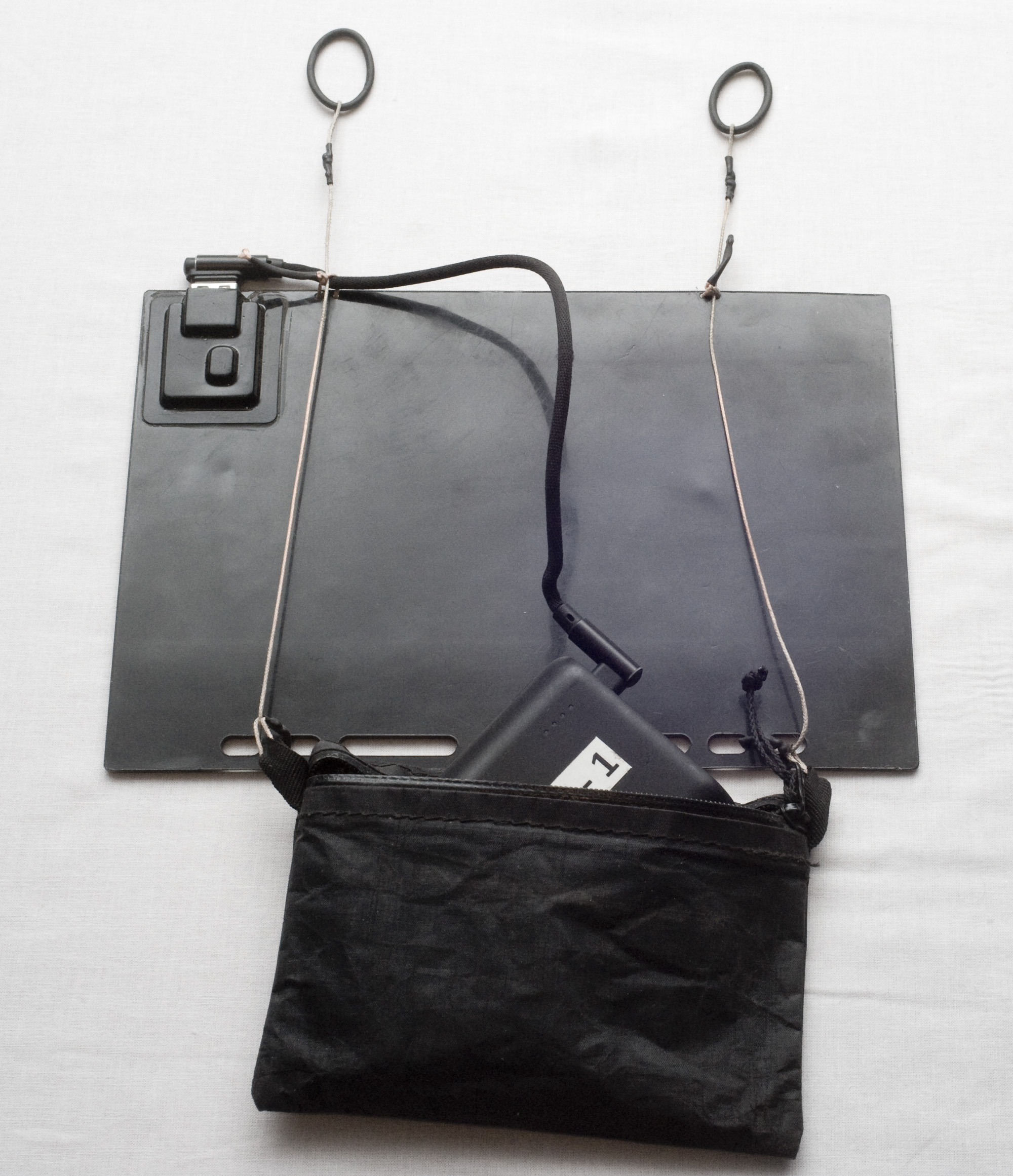
My approach: I use this solar panel to charge a 10 Ah power bank while hiking. In the evening and night I serially recharge my devices out of the power bank and accept the reduced efficiency for ease of use. I carry a 2nd 10 Ah power bank for emergency.
In addition I will send a USB wall charger in my resupply bucket to VVR, to be able to have a full recharge there. Until then I will know if my solar charging works as expected, and can decide either to take the USB charger with me for a 2nd use at Red’s Meadow, or just drop it in the VVR hiker box after use.
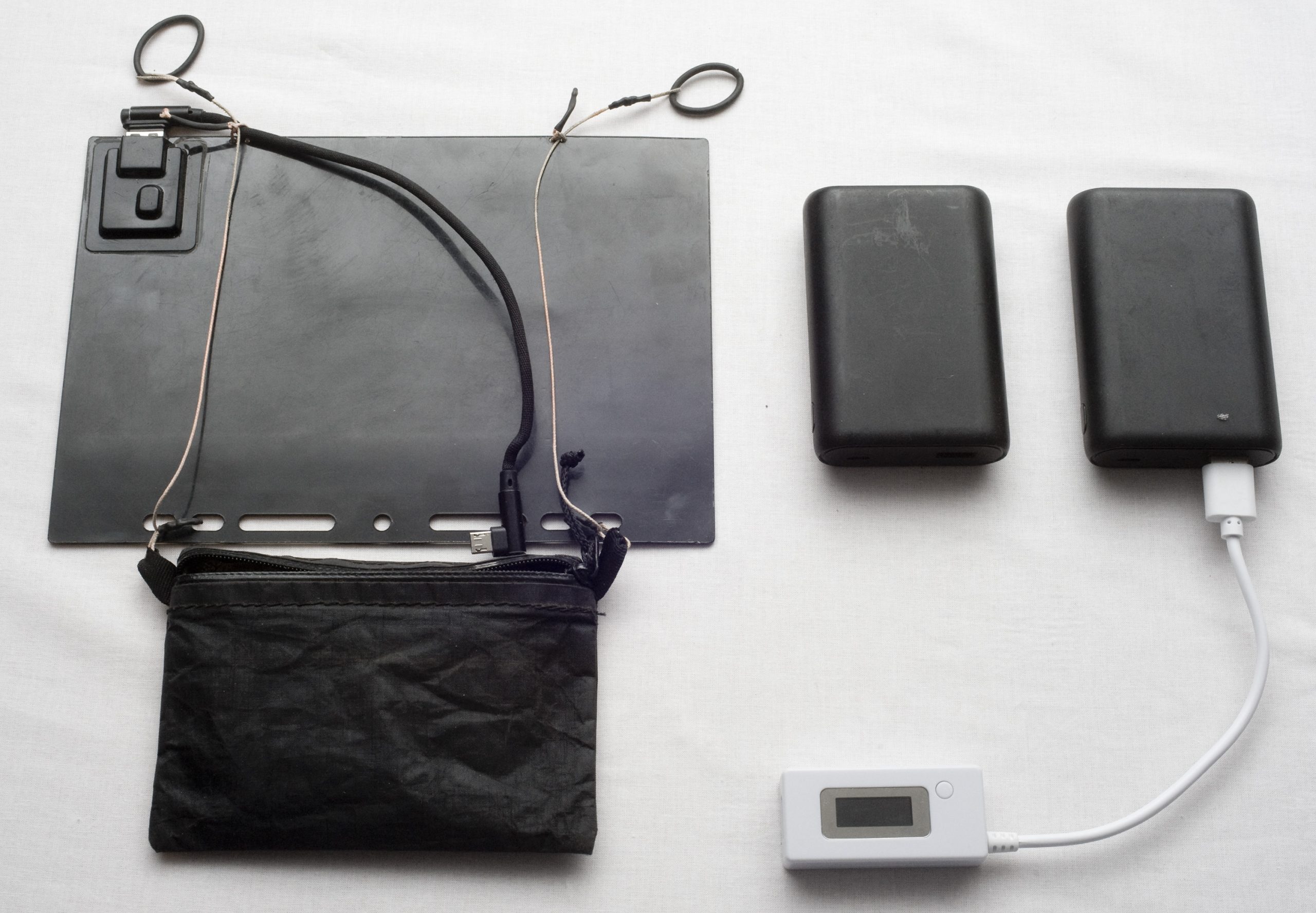
I also tested to charge the camera batteries directly from the solar panel but the charger did not work reliably with the varying and sometimes interrupting power of the solar panel, and then did not restart by itself when enough power is back. There is the same risk for smartphones or other devices. Under controlled conditions you can use the solar panel for direct charging, e. g. during a rest.
Attention: solar charging during the hike will work well only if you fix the panel close to the top of the backpack and preferably go NoBo, with the sun on your back! Obviously it has to be sunny and you should walk above the tree line or at least a good part of the day out of the woods. Your revenue will vary.
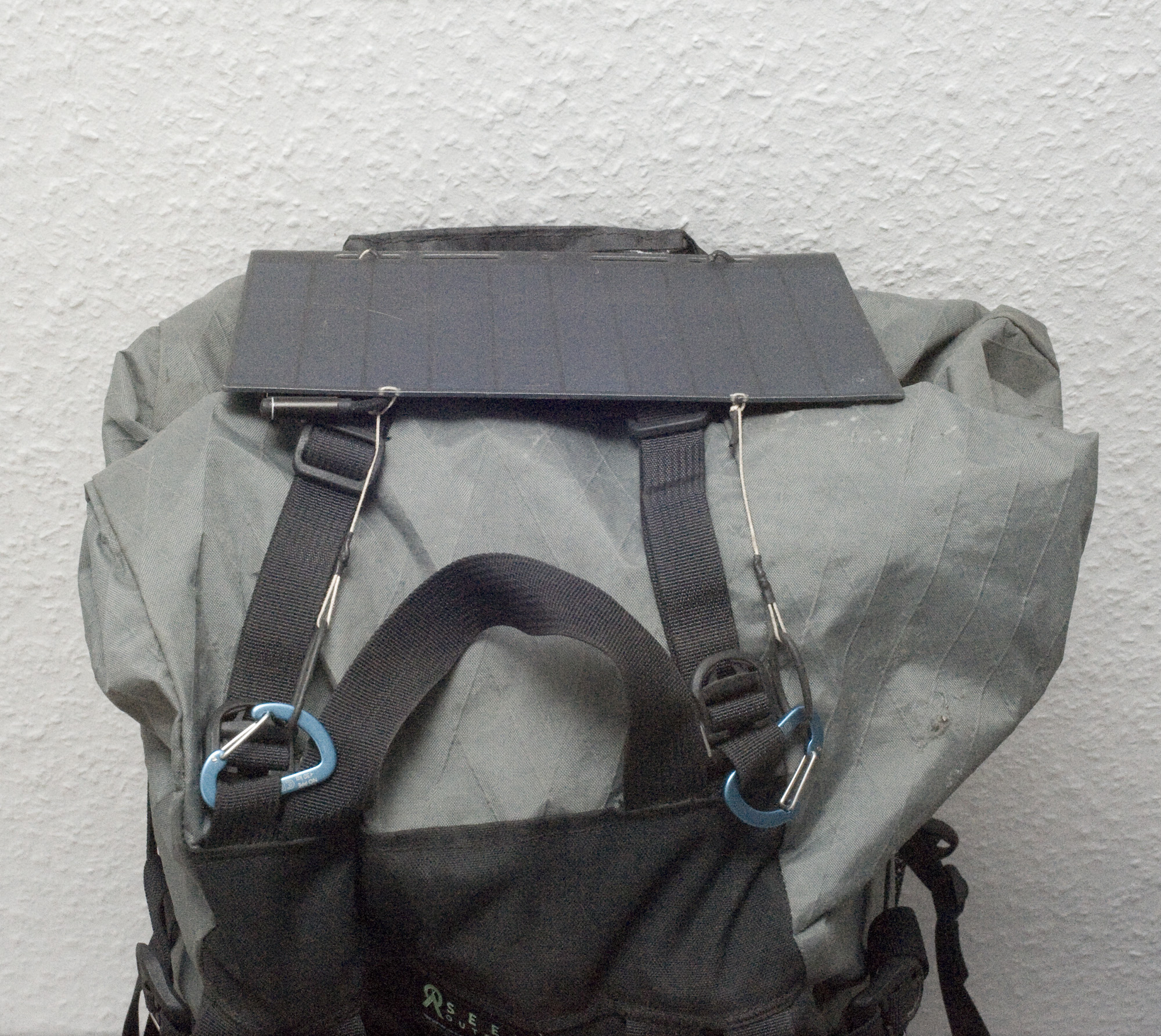

My attachement to the backpack used small snap hooks together with the O-rings. The weight of the power bank helps to keep the panel in place, but later I found it preferable to fix the power bank further with the V strap that keeps the pack closed, and thus hold the panel in place even while bushwacking. When I open the pack I flap the panel over to the other side.
Update after the hike: the solar charger worked very well. While the power bank was often not fully charged in the evening I never ran out of power with it. The 4 camera batteries allowed me to stretch my energy needs over several days – on a bad day I did not recharge them directly the next night. The smartphone also had enough margin for more than one day. I always recharged the inReach to 100%.
When I arrived already in the afternoon at the camp site – i. e. rarely – I could use the extra time with optimum position of the panel for an extra boost. On the whole hike I did not touch the 2nd power bank I carried in the pack just because I never needed its extra energy. The panel got some scratches walking under fallen trees and elsewhere through the bushes which may have reduced its efficiency a bit but it did not fail.
The line charger at VVR did NOT work well. I got it only late with my resupply bucket, and the generator stops in the evening, so I could not fully recharge during this night. I did not keep the charger and did not recharge from line power at Red’s Meadow or Tuolumne Meadows.
The weight of my items for power generation and storage:
-
- solar panel with harness, cable and bag: 90 g
- 10 Ah power bank: 180 g (2 x)
- camera battery: 50 g (4 x)
- smartphone battery: built-in (included in its 170 g)
- wall charger: 50 g
On trail I carried a total of about 650 g apart from the smartphone.
Update: on my next Sierra hike in 2022 I used a slightly bigger panel and a single 10 Ah power bank, with a total weight a bit below 300 g. No charger. Saved 200 g.
